by Judy Weaver Gonyeau, managing editor
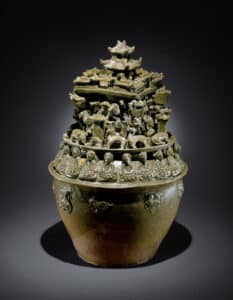
Cremation as a form of burial goes back to the Neolithic or Stone Age, making it one of the oldest traditions in the history of Man. Its propriety is also one of the longest debates across time as different influences—mainly cultural and religious in nature—come and go, even to this day.
The urn (funerary urn, cremation urn, burial urn, cinerary urn) has been used by various civilizations, whether for religious reasons or otherwise, since about 7000 B.C. in China. A discovery was made in one of the oldest provinces, Jiahu, that also indicates the urns were mainly used for children and on occasion, adults.
A Worldwide Phenomenon
The use of urns spread around the world as people crossed the planet. In Europe, they appeared starting in 3000 B.C. They were found among the Slavic peoples in western Russia and in the Near East. During the Bronze Age (2500-1000 B. C.), cremation moved into North America, the British Isles, Spain, and Portugal.
However, it was the discovery of a Bronze Age urn in Norfolk, England that captured the attention of Sir Thomas Brown. In his publication Hydriotaphia in 1658, Brown described the variety of funeral antiquities that were discovered in Norfolk and later went on to study burial and burial customs both ancient and in his time.
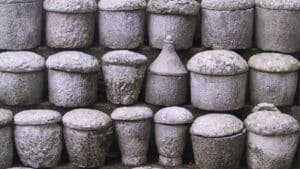
The Greeks and Romans
During the Mycenaean Age (1000-800 B.C.), intricate burial practices using urns were taking place to honor the dead and protect the living. Due to the large number of soldiers being killed during various wars, the Greeks turned to cremation to dispose of the bodies and used urns to honor the dead as it was seen as the most sanitary way to complete the task.
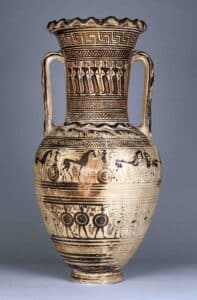
There were a variety of urns designed and used by the Greeks – Amphorae, Oinoche, Kraters, and Kylix. The Greek funeral pyre included much more than the body – it also included the bodies of livestock, food, messages to the dead, and sometimes the body of an enemy or two. Flowers were also placed around the pyre.
The Roman Empire (27 B.C. to 396 A.D.) embraced the practice of cremation, especially for those of high status. Their remains were placed in elaborately painted urns that were then stored in a version of a columbarium building. The building was typically built at least partially underground or completely underground.
Cremation became so popular among the Romans that an official decree was made to stop cremation from taking place in the city.
With the rise of Christianity, cremation, and therefore urns, fell out of favor as full-body burial became the more accepted way to intern the dead with exceptions made in times of plague or war. Eastern Orthodox Churches, Orthodox Jews, and Muslims all felt cremation was against their religions, and the preference for full-body burial continues today.
A Plethora of Urns
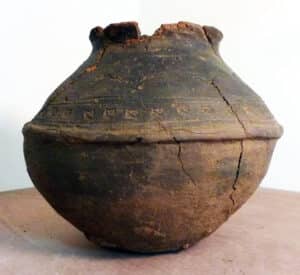
According to GetUrns.com, in Central European there was a series of large, elaborate urn cemeteries made from 1300-750 B.C. called “Urnfield Culture.” This was a time and place where large, elaborate urn cemeteries were built. “Their funeral practices were similar to the Greeks. Their dead would be put on display, and earthly valuables and food would be set near the body to honor the deceased. Elegies, which were songs and poems, would be sung to further honor the dead. The website stated:
“After a feast, the body would be burned, and the ashes placed in urns. These urns were typically buried, and a stone would be placed at the site to memorialize the deceased. “Over time, these stones would build up to create cairns,” which are human-made stacks, mounds, or piles of rocks that served as monuments, burial sites, or ceremonial grounds.
Cremation Turns a Page
The latter half of the 1800s was known for its innovation in how things were made and done. Before the 1870s, the use of urns for storing the remains of a cremated body remained unpopular and the practice of cremation appeared unseemly.
Thanks to Sir Henry Thompson, surgeon to Her Majesty Queen Victoria, cremation took a modern turn. According to theforesightcompanies.com, “Thompson was concerned with hazardous health conditions posed by bodies before burial and assumed that post-burial contamination was also a danger.” Thompson took a particular interest in an innovative way to handle cremation being developed in Italy, making it a more accessible and simpler process – something he then fostered in the British Isles.

In the 1870s, Professor Ludovico Brunetti invented the first commercial cremation chamber, demonstrating the invention at the Vienna Exposition of 1873, with an updated version shown at the 1876 World’s Fair held in Philadelphia. In 1874, Thompson established the Cremation Society of England and supported the use of cremation through his many contacts and influential friends.
Another influencer promoting cremation came to the fore during the mid-to-late 1800s. A philosophy merged with theocracy and was named The Theosophical Society, which was founded in New York City in 1875 and then arrived in England.
The Theosophical Society believed that spirits of the dead could be contacted by mediums because they now existed on a higher plane. This led to more discussion on the matter of death and what to do with a dead body so that the spirit could continue on. The Society saw cremation as a way to allow the spirit to rise to this higher existence with ease by cremating the body. Supporting and promoting the use of a crematorium made sense.
According to legendurn.com, “In 1878, Woking, England and Gotha, Germany were home to the first European crematories in Europe. … The return [to cremation] was not smooth at first, but changing attitudes caused a huge rise in the number of people opting for it.” In quick succession following the first structure, crematoriums opened up across America and Europe, and urns became an important consideration after a loved one’s death.
Urn Design and Value
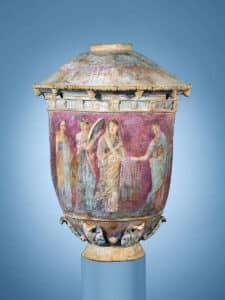
Strictly speaking, an urn is a vase with a narrowed neck and a cover, typically made of pottery, porcelain, sometimes metal, and rarely, glass. Today, almost any shaped container can be called a funeral urn, as its intent determines its name.
Because of the breadth and character of design used in making urns, they are very collectible. At antique-hq.com, they offer a list of qualities to consider when looking at an urn to add to a collection:
• While most cremation urns were usually made with a matching lid, older urns and urns from different cultures may not have used a lid per se, they may have corked or capped off the opening instead.
• Older pieces, such as Roman burial urns, may not have their lids anymore. Many were damaged or lost over time.
• The modern-style urn has been around since the 1870s. Before then cremation/burial urns were bulky and heavy. In most cases, they were formed using a more simplistic design, strictly intended to store the ashes of the deceased as a sign of respect, nothing more.
• More well-to-do families may have opted for a more ornate design to show off their wealth, so these urns may have been decorated with imagery, or have been made by master potters or stonemasons, and have intricate carvings and elaborate designs.
• Urns could have been made of different materials such as clay, marble, bronze, wood, brass, stone, and even glass. Each region and time period would have used what was available to them at the time of their construction.
• Do your research into a particular piece and check that the design and material match the alleged age and location. Also, look for signs of wear and tear through repeated use, to help determine if it was a jug (wine stains are a dead giveaway), or an urn (there may be a name, religious verse, or symbol that could be found either inside or outside of the urn pending culture or era).
Prices can range from a few hundred to hundreds of thousands of dollars depending on age, condition, and beauty. Whether or not you use them for their named purpose is up to you.





Related posts: